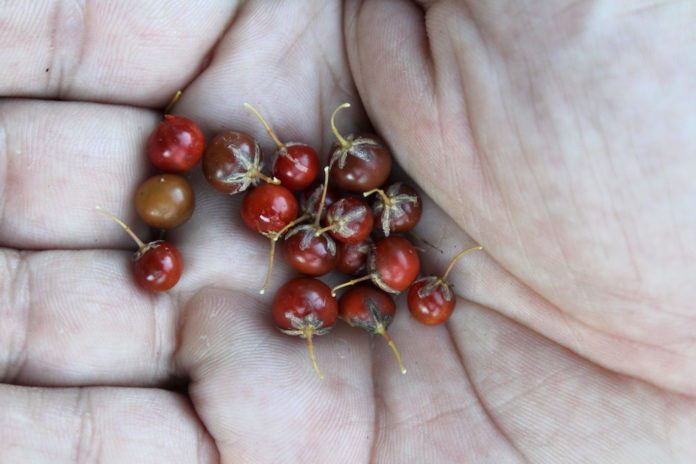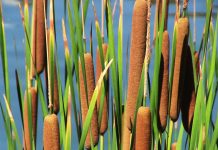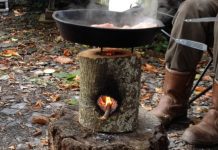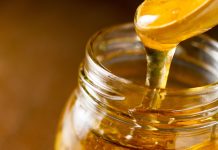Starting asparagus from seed is easy, and it’ll save you a lot of money compared to buying pricey asparagus crowns. Nurseries sell asparagus crowns, which are just bare root 1-year-old plants, for as much as $5 each. A potted asparagus plant will set you back $10 to $12 in the spring. A single seed packet, on the other hand, costs about $3 for a pack of 50 to 100 seeds. That’s a tiny investment for a whole field of homegrown asparagus.
Can You Grow Asparagus from Seed?
Yes! Asparagus is a flowering plant that produces seeds, just like any other garden crop. For many years I believed that Asparagus was a fern, and could only be propagated by division. I had never seen Asparagus “go to seed” because the asparagus crowns purchased from garden centers are all males. The female asparagus plants don’t produce nearly as many edible shoots, and instead, devote their energy to making seed.
Like so many of our food crops, asparagus flowers are bee-pollinated. Male and female plants are separate, and a bee must first visit a male asparagus flower on a male plant followed by a female flower on a female plant.


Since asparagus crowns are generally sold as male-only, you’ll only ever see the bright red asparagus fruits (seed pods) if you grow asparagus from seed. Or, in my case, get a batch of asparagus crowns that happen to contain several female plants. Something went wrong in the selection process, and roughly 1/3 of the asparagus crowns I ordered were female.
The female plants are usually culled out because they produce far fewer harvestable spears. With 1/3 of my asparagus beds planted with female plants, the harvests are pretty slim each spring. But a ready source of female plants means that I have plenty of asparagus seed to plant each year.
When you grow asparagus from seed, you’ll have a choice. Either keep the female plants or cull them out to make room for more productive male plants. As a home grower, culling out the female plants will result in a better harvest, but then you won’t be able to save asparagus seed. You also won’t get to enjoy the beautiful bright red asparagus fruit in the fall.
Related: How To Kickstart Your Homesteading Skills


Saving Asparagus Seed
The seeds start out as dense clusters of round green seedpods. They’ll take months to ripen to a full dark red color. While at first, it may look like a huge harvest of asparagus seed, don’t count your eggs before their hatched. Many of those green asparagus seed pods will be knocked off by wind or rain or picked off early by birds, long before they ripen.
In that time, a dense crop of asparagus seed will be reduced to no more than a small handful of ripe asparagus seeds per plant. That handful of asparagus seed pods still yields quite a few plantable seeds. Each asparagus fruit contains several seeds, and a single female asparagus plant can produce hundreds of seeds in a good year, even accounting for losses.


Leaving just one or two female asparagus plants in your patch is often enough to ensure a lifetime supply of seed, provided those female plants to survive and thrive. If you don’t cull out the female asparagus plants, they’ll be roughly 1/2 of your total plants. After planting asparagus from seed, allow the plants to mature for a few years until you can identify the female plants. At that point, I’d suggest culling down to half a dozen female plants at most.
To save asparagus seeds, harvest the berries when once they’ve turned bright red in the fall. Here in Vermont (zone 4), that happens in mid to late September. Allow the berries to dry for a week or two, and then carefully break the seed pods open and extract the seeds.
Lay the seeds out to dry for at least another week before storing them to plant the following spring.


Growing Asparagus from Seed
Planting asparagus seeds is a simple process, and it doesn’t matter whether you’ve saved your own seed, or purchased a package of asparagus seed. Start the seeds indoors 10 to 12 weeks before the last expected frost date in your area. In my cold Vermont climate, the last frost happens the first week of June. That means I’ll need to plant asparagus seed in mid to late March. Most locations see spring a good bit earlier than we do here, and asparagus seeds can be started sometime in February.
Plant asparagus seeds about 1/2 an inch deep in fertile potting soil. The seeds need soil temperatures between 70 and 85 degrees F for good germination, so it’s a good idea to invest in a seedling heat mat. Since most garden crops only need to be started 6 to 8 weeks early, you can reuse the heat mat for tomatoes and peppers later on once the asparagus has germinated.
In the best of conditions, Asparagus takes between 2 and 4 weeks to germinate. Some seeds can take as much as 8 weeks to germinate. That’s one reason why the seeds need to be started so early in the spring. Pre-soaking the seeds in lukewarm water for a few hours before planting can help speed germination, but it’s not strictly necessary.
Related: How to Grow and Harvest Sweet Potatoes
Transplanting Asparagus Seedlings
Unlike asparagus crowns, which have a large root mass, asparagus seedlings are just getting established. Take extra care in handling them, and avoid damaging their roots. Plant them a bit denser than you would crown to allow for some dieback.
Transplant asparagus seedlings to the garden after the risk of the last frost has passed in your area. That’s the same time you set out tomato plants. Crowns are planted 18 to 24 inches apart, but try spacing seedlings about 6 inches apart in rows 18 inches apart. If all the plants thrive, the extra crowns can be thinned out or transplanted later.


How Long Until Harvest?
When you plant asparagus from seed, you’re one year behind schedule compared with planting asparagus crowns. Crown planted asparagus can be harvested in carefully in the 2nd year and fully in the third year. For seed planted asparagus, harvest just a few spears in the third year and then you’ll be able to harvest a full crop in the 4th year.
In the meantime, just carefully tend the asparagus spears, keeping the beds free of weeds. In a few years, they’ll fill out the beds and give you a good crop in the spring as well as showy foliage in the fall.





















